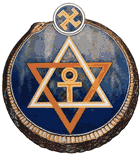Nāga: Difference between revisions
Pablo Sender (talk | contribs) No edit summary |
No edit summary |
||
| Line 25: | Line 25: | ||
[[Category:Sanskrit terms]] | [[Category:Sanskrit terms]] | ||
[[Category:Theosophical concepts]] | [[Category:Theosophical concepts]] | ||
[[Category:Hindu | [[Category:Hindu concepts]] | ||
[[Category:Buddhist | [[Category:Buddhist concepts]] | ||
Revision as of 15:35, 30 May 2012
Nāga (devanāgarī: नाग) is the Sanskrit word for a deity in the form of a very great snake (specifically the King cobra), found in Hinduism and Buddhism. The use of the term nāga is often ambiguous, as the word may also refer, in similar contexts, to one of several human tribes known as or nicknamed "Nāgas"; to elephants; and to ordinary snakes, particularly the King Cobra and the Indian Cobra.
In a Theosophical context, H. P. Blavatsky defined it as follows:
Nâga (Sk.). Literally “Serpent”. The name in the Indian Pantheon of the Serpent or Dragon Spirits, and of the inhabitants of Pâtâla, hell. But as Pâtâla means the antipodes, and was the name given to America by the ancients, who knew and visited that continent before Europe had ever heard of it, the term is probably akin to the Mexican Nagals the (now) sorcerers and medicine men. The Nagas are the Burmese Nats, serpent-gods, or “dragon demons”. In Esotericism, however, and as already stated, this is a nick-name for the “wise men” or adepts in China and Tibet, the “Dragons.” are regarded as the titulary deities of the world, and of various spots on the earth, and the word is explained as meaning adepts, yogis, and narjols. The term has simply reference to their great knowledge and wisdom. This is also proven in the ancient Sûtras and Buddha’s biographies. The Nâga is ever a wise man, endowed with extraordinary magic powers, in South and Central America as in India, in Chaldea as also in ancient Egypt. In China the “worship” of the Nâgas was widespread, and it has become still more pronounced since Nâgarjuna (the “great Nâga”, the “great adept” literally), the fourteenth Buddhist patriarch, visited China. The “Nâgas" are regarded by the Celestials as “the tutelary Spirits or gods of the five regions or the four points of the compass and the centre, as the guardians of the five lakes and four oceans” (Eitel). This, traced to its origin and translated esoterically, means that the five continents and their five root-races had always been under the guardianship of “terrestrial deities”, i.e., Wise Adepts. The tradition that Nâgas washed Gautama Buddha at his birth, protected him and guarded the relics of his body when dead, points again to the Nâgas being only wise men, Arhats, and no monsters or Dragons. This is also corroborated by the innumerable stories of the conversion of Nâgas to Buddhism. The Nâga of a lake in a forest near Râjagriha and many other “Dragons” were thus converted by Buddha to the good Law.[1]
Sesha Nāga
In Hindu mythology, Seshanāga or Shesh Nag (also known as Ananta) is a massive serpent that floats coiled in space, or on the universal ocean, to form the bed on which Vishnu lies. Its name means "that which remains", from the Sanskrit root shiş, because when the world is destroyed at the end of the kalpa, Shesha remains. Occasionally, Shesha is shown as a five headed snake. But in his real form he has 1000 heads with each one wearing a crown.
Sesha is referred variously as Adisesha (the first Sesha), or Anantasesha (Endless Sesha). According to Mme. Blavatsky, Ananta is a symbol for space (and therefore primordial matter):
Sesha-Naga, the King of the “Serpent” race, is synonymous with Ananta, the seven-headed Serpent, on which Vishnu sleeps during the pralayas. Ananta is the “endless” and the symbol of eternity, and as such, one with Space, while Sesha is only periodical in his manifestations.[2]
Ouroboros
The Ouroboros (or Uroborus) is an ancient symbol depicting a Serpent or dragon swallowing its own tail. The name originates from within Greek language oura (οὐρά), meaning "tail" and boros (βόρος) meaning "eating". It represents the perpetual cyclic renewal of life and infinity, the concept of eternity and the cyclic return or reincarnation.
This symbol is present in the emblem of the Theosophical Society.
